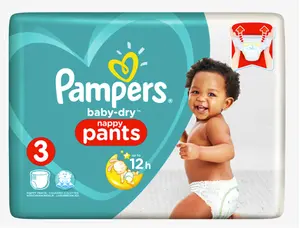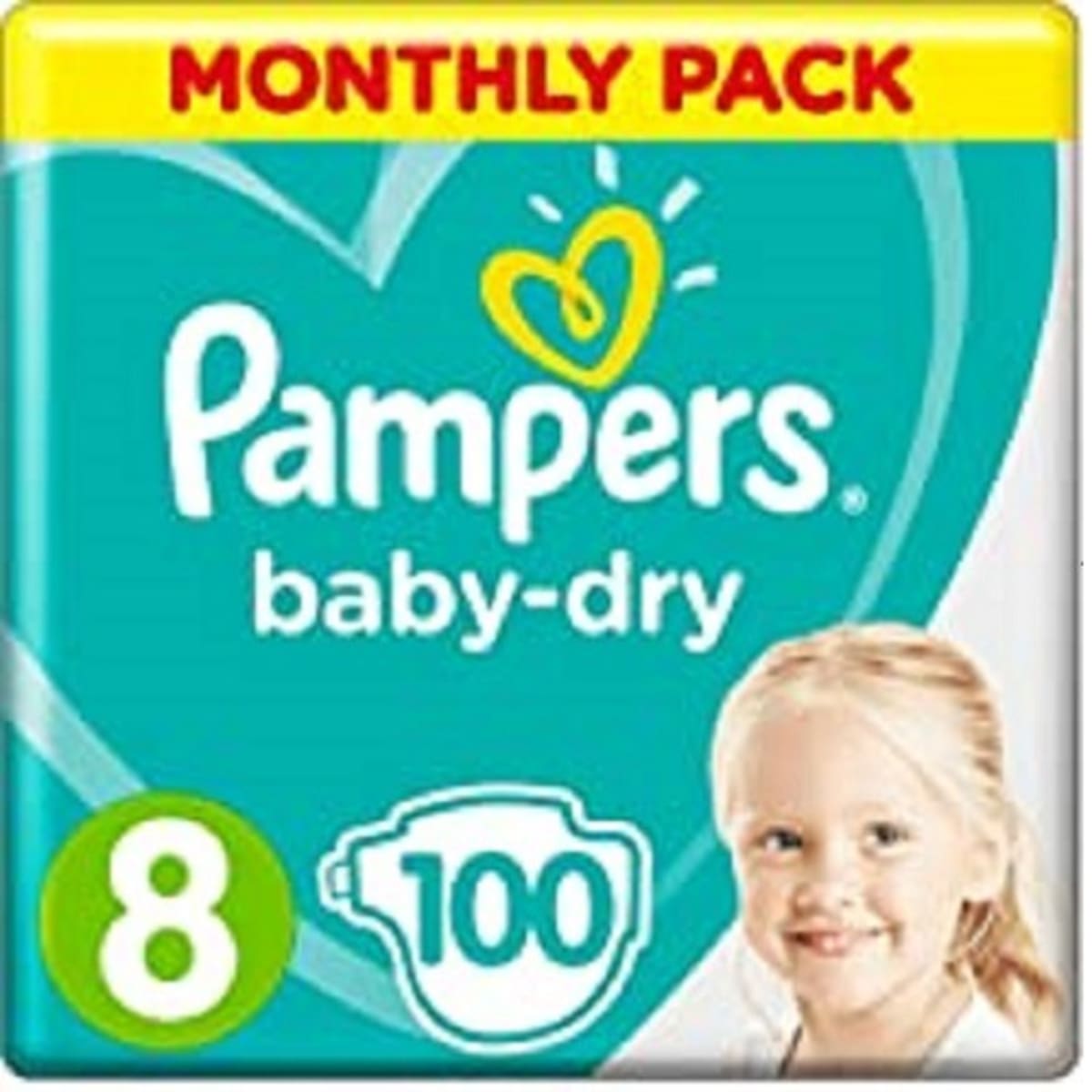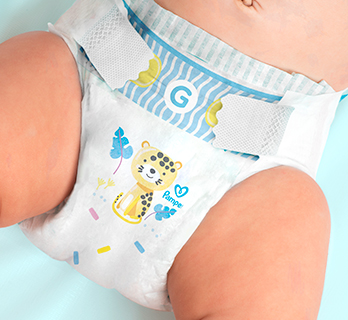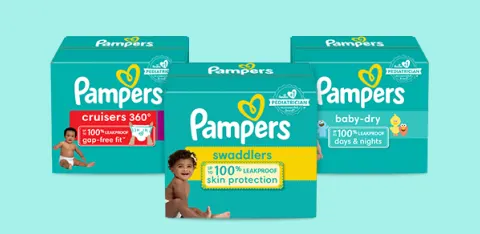Pampers: Revolutionizing Baby Care Through Innovation
Pampers, a pioneering brand under Procter & Gamble, is globally acclaimed for its innovative approach to baby care. Renowned for introducing the first disposable diaper in the 1960s, Pampers has continually revolutionized the industry, offering a diverse range of high-quality, comfortable, and absorbent diapers tailored for different developmental stages. Embracing innovation and sustainability, Pampers has not only reshaped the parenting experience but also engages in community initiatives, providing support and resources to families worldwide. Trusted by millions, Pampers remains a cornerstone in the realm of baby care, committed to ensuring the well-being of infants while making parenting more convenient and comfortable.
Innovative Technologies.

In the realm of baby care, Pampers stands as a household name and a pioneer in the development of baby diapers. For decades, the brand has been synonymous with quality, reliability, and innovation. Since its inception in the 1960s, Pampers has consistently evolved to meet the ever-changing needs of babies and parents. This article aims to explore the remarkable journey of Pampers, highlighting its innovative contributions to the baby care industry and the impact it has had on millions of families worldwide.
Origins of Pampers
Pampers, a brand owned by Procter & Gamble, came into existence in the early 1960s when a P&G researcher, Vic Mills, sought to create a disposable, more convenient alternative to cloth diapers. This pursuit led to the development of the first-ever disposable diaper in 1961. This product aimed to revolutionize the way parents approached baby hygiene, eliminating the hassle of washing and reusing cloth diapers.
Innovation and Evolution
Over the years, Pampers has been a consistent trailblazer in the industry, continually improving its products through innovative technologies and materials. The brand introduced features such as elastic leg gathers, adhesive tabs, and absorbent cores, enhancing the overall comfort and functionality of diapers. Pampers has also expanded its product line to include various sizes catering to different age groups, from newborns to toddlers.
Pampers has focused not only on the practical aspect of diapering but also on the health and well-being of babies. They've introduced materials that are gentle on delicate baby skin, creating diapers that are not only highly absorbent but also soft and hypoallergenic.
Moreover, the brand has been at the forefront of sustainability initiatives, aiming to reduce its environmental footprint. Pampers has worked on developing eco-friendly diapers, incorporating plant-based materials and reducing waste through improved manufacturing processes.
Technological Advancements
In recent years, Pampers has delved into the realm of technology by introducing smart diapers. These diapers come equipped with sensors that can alert parents through an app when the baby needs a diaper change. This technological leap has not only provided convenience but also contributes to proactive baby care, ensuring the baby's comfort and health.

Impact on Families
The impact of Pampers on families globally cannot be overstated. The brand's commitment to creating high-quality, reliable, and convenient products has significantly simplified the lives of parents. By offering a range of diapers that accommodate different needs and developmental stages, Pampers has been instrumental in easing the challenges of parenting.
Pampers has also extended its reach beyond just diapering. The brand has invested in community initiatives, providing support to parents, and collaborating with healthcare professionals to promote awareness about baby care.
Types of Pampers
Pampers offers a wide range of diapers tailored to meet the various needs of babies at different developmental stages. Some of the primary types of Pampers diapers include:
- Pampers Swaddlers: Ideal for newborns, these diapers are designed with a unique Absorb Away Liner that pulls wetness and mess away from delicate skin, providing a comfortable fit and reliable protection.
- Pampers Baby Dry: Known for their excellent absorbency, these diapers are perfect for overnight use. They feature three layers of absorbency and provide up to 12 hours of protection, keeping babies dry and comfortable while sleeping.
- Pampers Cruisers: Specifically designed for active babies and toddlers, these diapers have a flexible design that allows for easy movement. They come with extra absorb channels for long-lasting dryness and fit comfortably during active play.
- Pampers Pure: Catering to parents looking for a more natural option, Pampers Pure diapers are made with premium cotton and plant-based materials. They are free from chlorine bleaching, fragrance, and parabens, offering gentle care for baby's delicate skin.
- Pampers Splashers: Perfect for water activities, these swim diapers are designed to not swell in water. They offer a comfortable fit for playful moments in the pool or at the beach.
- Pampers UnderJams: Geared towards older kids, these are absorbent nightwear pants designed to provide discretion and comfort while offering overnight protection.
Benefits of Pampers
There are numerous benefits associated with using Pampers diapers, which have made them a popular choice among parents globally. Some of these advantages include:
- Convenience: Pampers diapers offer a high level of convenience to parents. They eliminate the need for washing and drying cloth diapers, saving time and effort. The ease of disposal after use reduces the workload for busy parents.
- Absorbency: Pampers are known for their exceptional absorbency, keeping babies dry for extended periods. The diapers contain super-absorbent materials that quickly pull moisture away from the baby's skin, reducing the risk of rashes and discomfort.
- Fit and Comfort: Pampers diapers are designed with a snug fit, offering flexibility and comfort for babies. The elastic leg gathers and adjustable tabs ensure a secure fit, preventing leaks while allowing freedom of movement for the baby.
- Skin Health: Pampers prioritize the use of materials that are gentle on sensitive baby skin. Their diapers are hypoallergenic and free from harmful chemicals, reducing the risk of skin irritation and rashes.
- Range of Sizes and Styles: Pampers offers a diverse range of sizes and styles suitable for babies at different stages of development. From newborn sizes to larger ones for active toddlers, the variety ensures a proper fit and maximum protection at every growth phase.
- Nighttime Protection: Pampers Nighttime diapers are specially designed for overnight use, providing extra absorbency to keep babies dry and comfortable through the night, reducing disruptions in sleep for both the baby and the parents.
- Innovation and Technology: Pampers continuously integrates new technology into their products. Smart diapers equipped with sensors and indicators help parents know when a diaper change is needed, providing an extra layer of convenience and care.
- Sustainability: The brand has made strides in developing eco-friendly options, using more sustainable materials in their diapers and incorporating eco-conscious practices in their manufacturing processes to reduce environmental impact.
- Community Support and Initiatives: Pampers engages in community initiatives, offering support to parents and collaborating with healthcare professionals to promote awareness about baby care. They provide resources, education, and support for families.
- Trusted Brand: Pampers has established itself as a trusted and reliable brand, backed by decades of experience and research. Its commitment to quality and innovation has gained the trust of parents worldwide.

Uses of Pampers
Pampers, primarily known for their disposable diapers, have a range of uses beyond their obvious role in baby care. Here are some of the key uses of Pampers products:
- Baby Diapering: The primary and most common use of Pampers products is for diapering babies. Pampers offers diapers in various sizes and styles to suit different age groups and developmental stages of infants and toddlers.
- Overnight Protection: Pampers Nighttime diapers are specially designed for overnight use. They offer enhanced absorbency and protection, which is crucial for keeping babies dry and comfortable throughout the night, reducing disturbances in their sleep and ensuring a good night's rest for both the baby and the parents.
- Travel and Outings: Pampers diapers are a convenient choice for parents when traveling or going on outings with their babies. They provide an easy and hygienic solution for on-the-go diaper changes, ensuring that babies remain clean and comfortable during trips.
- Daycare and Nursery: Many parents opt for Pampers diapers when sending their babies to daycare or nurseries. The reliability and ease of use make them a practical choice for caregivers in group settings.
- Postpartum Use: Some parents use Pampers products for postpartum purposes, particularly in the days immediately after giving birth. The absorbent and comfortable nature of these diapers can be helpful for managing postpartum bleeding.
- Pet Care: Pampers diapers are sometimes repurposed for pet care. They can be used as makeshift diapers for dogs or cats that are incontinent or have other medical issues, providing a convenient way to manage the needs of pets with special requirements.
- Elderly Care: Pampers products are occasionally used for elderly care, especially for seniors who require incontinence management. The diapers' absorbent capabilities make them a practical choice for ensuring the comfort and dignity of elderly individuals.
- Craft and DIY Projects: The soft and absorbent materials in Pampers diapers can be repurposed for various craft and DIY projects. They are sometimes used for making baby shower gifts, diaper cakes, or other creative endeavors.
- Absorbent Pads: In emergency situations, Pampers diapers can be disassembled to create makeshift absorbent pads. These pads can be used for cleaning up spills, providing temporary cushioning, or other absorbent needs.
- Community and Humanitarian Initiatives: Pampers has been involved in various community and humanitarian initiatives, providing diapers to families in need during disasters or difficult times. Their products have been valuable in ensuring the well-being of babies and families facing adversity.
Product Range on Pampers
Pampers offers a diverse line of diapers catering to various age groups and developmental stages of infants and toddlers. From Newborn sizes to Active Baby Pants, Pampers provides a broad range to suit different needs and preferences.
Quality and Comfort of Pampers
The brand is renowned for its focus on quality, ensuring that its diapers are not only highly absorbent but also gentle on a baby's sensitive skin. Pampers diapers feature soft materials and innovative designs that provide both comfort and protection.
Community and Support
Pampers engages in various community initiatives aimed at supporting parents and caregivers. They collaborate with healthcare professionals to provide resources, education, and support for families.
Sustainability Initiatives
Acknowledging its environmental impact, Pampers has made strides in sustainability. The brand has introduced eco-friendly diaper options, reducing their environmental footprint through the use of more sustainable materials and improved manufacturing practices.
Trusted Reputation
Pampers has earned the trust of parents globally. With decades of experience, the brand's commitment to innovation, quality, and meeting the diverse needs of babies and parents has established it as a reliable and leading name in the industry.

Environmental Impact on Pampers
Pampers, like many other consumer products, has an environmental impact throughout its lifecycle, from raw material sourcing to manufacturing, distribution, usage, and disposal. Here's an overview of the environmental impact of Pampers diapers:
- Raw Materials: The materials used in Pampers diapers, such as super-absorbent polymers, plastics, adhesives, and cellulose, are primarily derived from non-renewable resources. The extraction and processing of these materials contribute to environmental strain.
- Manufacturing: The manufacturing process involves energy consumption, water usage, and greenhouse gas emissions. Pampers diapers are manufactured in large-scale facilities that require significant amounts of energy and water, and the production processes can generate carbon emissions.
- Packaging and Transportation: The packaging of diapers, along with the transportation of raw materials and finished products, contribute to the brand's carbon footprint. The use of plastics and the energy required for transportation further impacts the environment.
- Waste Generation: Disposable diapers contribute to waste accumulation in landfills. The slow decomposition of diapers due to their synthetic materials adds to environmental concerns. It's estimated that traditional disposable diapers can take hundreds of years to decompose.
- Sustainability Efforts: In recent years, Pampers has made efforts to address these environmental impacts. They have introduced eco-friendly diaper options that use more sustainable materials. These diapers incorporate elements like plant-based materials and have improved manufacturing processes to reduce their overall environmental impact.
- Recycling Initiatives: Pampers has also explored recycling programs in certain regions. However, recycling diapers poses significant challenges due to the complex mix of materials used in their production.
- Sustainability Goals: The brand has committed to setting and achieving sustainability goals. This includes reducing their carbon footprint, water usage, and waste generation. They aim to innovate further to create more environmentally friendly diapering solutions.
- Consumer Education: Pampers has also focused on educating consumers about responsible disposal methods and the importance of proper waste management to reduce the environmental impact of diapers.
Frequently Asked Questions (FAQ)
Is it called diapers or Pampers?
The term "diapers" is a general and generic word used to refer to the absorbent garments worn by babies or individuals who are unable to control their bladder or bowel movements. "Pampers," on the other hand, is a specific brand name that produces and markets diapers among other baby care products.
While "diapers" is a broad term used to describe a range of absorbent undergarments, "Pampers" specifically refers to the brand of diapers produced by Procter & Gamble. Just as "Kleenex" is a brand of facial tissues and "Band-Aid" is a brand of adhesive bandages, "Pampers" is a widely recognized brand name for diapers. However, people might commonly use the brand name "Pampers" as a generic term for diapers due to its popularity and widespread usage, similar to how brand names sometimes become synonymous with the general product category.

Which type of Pampers is best?
Determining the "best" type of Pampers diapers depends on various factors, including your baby's age, size, specific needs, and personal preferences. Different types of Pampers cater to different requirements and stages of a baby's development.
Why are Pampers so much more expensive?
Pampers may appear more expensive compared to some other diaper brands for several reasons, including:
- Quality and Technology: Pampers invests in research, development, and advanced technology to create high-quality diapers. The brand's focus on innovative designs, high absorbency, and comfort for babies contributes to a higher production cost.
- Material Quality: Pampers often uses premium and soft materials that are gentle on a baby's skin. These materials might be of higher quality compared to generic or store-brand diapers, leading to a higher cost of production.
- Innovative Features: Pampers diapers often come with additional features, such as wetness indicators or specific designs for newborns, active babies, or overnight use. These extra features contribute to the overall cost.
- Brand Recognition and Trust: Pampers has established itself as a reputable and trusted brand in the baby care industry. The reliability, quality, and long-standing reputation can lead to a premium pricing strategy.
- Research and Development: Pampers invests significantly in ongoing research, product testing, and improvement. This continuous innovation in technology and materials might drive up the overall cost of production.
- Advertising and Marketing: Brands like Pampers often spend a substantial amount on marketing and advertising to maintain their market presence, which can add to the product's overall cost.
- Economies of Scale: Pampers might not benefit from the same economies of scale as generic or store-brand diapers. As a premium brand, it might not produce in the same high volumes as some lower-cost alternatives, impacting the cost per unit.
How long do Pampers last?
The duration a Pampers diaper can last largely depends on the baby's age, size, urination frequency, and the specific type of diaper used. Generally, here's an approximate guideline for how long Pampers diapers may last:
- Newborns to Infants: For newborns and younger infants, diapers might need to be changed more frequently, roughly every 2 to 3 hours or as soon as the baby wets the diaper. Newborns tend to urinate frequently, and keeping them dry helps prevent skin irritation.
- Older Babies and Toddlers: As babies grow, their bladder capacity increases, and they may urinate less frequently. Diapers might last longer, around 3 to 4 hours or more, depending on the individual child's urination patterns and the specific Pampers type used, such as Pampers Baby Dry or Pampers Cruisers, which have higher absorbency.
- Overnight Use: Pampers Nighttime or other specialized overnight diapers are designed to offer extended protection and can last through the night, typically around 8 to 12 hours. However, changing a baby's diaper immediately after waking up in the morning is recommended.
Can we use Pampers for 10 hours?
Pampers, particularly some of their specialized types such as Pampers Baby Dry or Pampers Overnight, are designed to offer extended protection for up to 8-12 hours, specifically catering to overnight use. These diapers are formulated to provide enhanced absorbency, allowing babies to sleep comfortably without needing a diaper change during the night.
While these diapers are intended for extended use, it's essential to consider a few factors:
- Baby's Age and Urination Patterns: For infants and younger babies, frequent diaper changes are generally recommended to ensure they stay dry and avoid skin irritation. As babies grow, their bladder capacity increases, and they tend to urinate less frequently.
- Check and Change Promptly if Needed: Despite the extended protection feature, it's crucial to check the diaper periodically and change it promptly if it's wet or soiled, even if it hasn't been the full duration of 10 hours. Keeping the baby dry and comfortable is a priority to prevent discomfort and potential diaper rashes.
- Overnight Use: Pampers Overnight or specifically designed diapers for nighttime usage are meant to last through the night, providing the necessary protection for an extended period, typically around 8-12 hours.

Can I leave Pampers overnight?
Pampers, particularly their specialized overnight diapers such as Pampers Baby Dry or Pampers Nighttime, are designed for extended use, specifically catering to overnight wear. These diapers are formulated to provide enhanced absorbency, allowing babies to sleep comfortably without needing a diaper change during the night.
Leaving your baby in an overnight diaper is generally safe and commonly done by many parents. However, it's important to keep a few considerations in mind:
- Baby's Comfort: Overnight diapers are designed to provide extended protection, but it's crucial to ensure your baby's comfort. Check the diaper before putting your baby to bed and change it if it's already wet or soiled.
- Diaper Size: Ensure the diaper fits properly to avoid leaks. A well-fitted diaper can enhance its effectiveness in keeping your baby dry throughout the night.
- Check and Change if Needed: Though these diapers are designed for longer wear, if your baby wakes up or if you suspect the diaper is wet or soiled during the night, it's best to change it promptly to maintain your baby's comfort and skin health.
- Prevent Diaper Rashes: Even with specialized overnight diapers, it's important to maintain good hygiene and apply diaper creams or ointments as needed to prevent diaper rashes.
Pampers has been an influential force in the baby care industry, constantly redefining standards and setting new benchmarks for innovation and quality. From its humble beginnings as the pioneer of disposable diapers to its current status as a global leader in baby care, Pampers continues to evolve and adapt, making the lives of parents easier while ensuring the comfort and well-being of babies.
As the brand progresses, its focus on innovation, sustainability, and customer satisfaction remains unwavering. Pampers not only offers convenience but also symbolizes a commitment to the health and happiness of babies around the world. Through its dedication to technological advancements and community engagement, Pampers continues to shape the future of baby care, setting an exemplary model for the industry as a whole.



